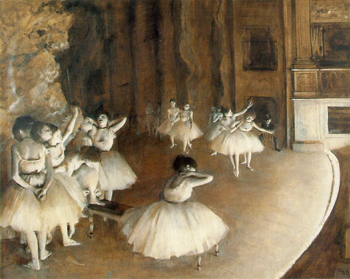
The Dance Classalso known as Ballet Rehearsal on the Stage

|
This painting, although small in size, is extremely important in establishing Degas as a masterful draftsman. When originally shown, the work inspired high critical praise and was very well-received. The charms of the piece, which appealed to the critics and members of the population who first saw the work, are not lost on the modern viewer.
A strong part of the allure of Ballet Rehearsal on Stage is its presentation of light. The stage is lit from below, and an unusual, almost haunting glow pervades the piece. The use of color is sparse. The image is monochrome, as Degas intended to use the work as a model for an engraver.
As is typical of Degas' ballerina series, this work portrays dancers at rest. A cluster of figures are gathered in the left foreground, standing next to a solitary ballerina who sits on a bench scratching her back. Another group of dancers rehearse in the distance, as their teacher watches from a seated position.
The thin layer of paint used in Ballet Rehearsal on Stage allows us to see the changes Degas made as he worked the canvas. The legs of the dancers in the foreground have been altered. A ballet master rehearsing with the two dancers at the far right was removed, as was another seated male figure originally placed on stage right.
There is a general consensus in the art world that Degas is not a colorist. He is instead acclaimed and admired for his excellent attention to detail and his correct and precise drawing. These commonly accepted notions about Degas may have originated from the critical response to Ballet Rehearsal on Stage. The highly positive critiques of this work emphasized these ideas and surely elevated the artist's reputation.












